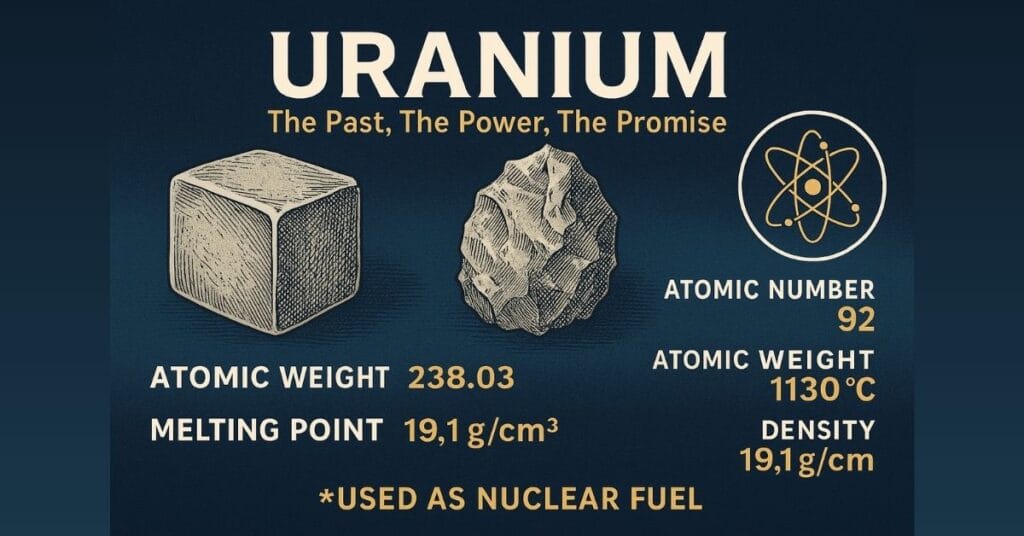Within the enormous universe of chemistry lies a phenomenal group known as the Actinide Family, and towering above its ranks is Uranium.
Uranium is a metal that has within it the secrets of great power, mysteries of atomic existence, and the keys to the atomic age.

It was in 1798 that the world heard about Uranium. A German chemist, Martin Heinrich Klaproth, discovered a new element while analyzing a mineral named pitchblende. Incidentally, a few days prior to his discovery, astronomers discovered a new planet, Uranus. Motivated by this astronomical phenomenon, Klaproth named the element Uranium in honor of the newly found planet.
It’s amazing how findings, both in the cosmos and on Earth, tend to echo one another, as if the universe is hinting at clues to those with the curiosity to hear.
But Klaproth’s find was merely the start.
In 1841, a scientist by the name of Eugène-Melchior Péligot carried the work forward. Following exhaustive experiments, Péligot was able to extract pure Uranium metal for the first time. Prior to his success, Klaproth had only been able to extract Uranium oxide, not the metal.
These are the kinds of moments that make me realize how science isn’t an overnight miracle, but a torch passed down from generation to generation, illuminating the unknown.
By 1896, Uranium’s full potential was being unlocked.
The renowned physicist Henri Becquerel found that Uranium gave off strange invisible rays, what we today refer to as radioactivity. This one sighting unlocked the gates of nuclear science and altered the course of human history for all time.
When I consider Becquerel’s discovery, I envision him standing there, unaware of opening up a time when stars might be born on Earth, both in power stations and, regrettably, on the battlefield. ⚡
The Role of Uranium in History
Uranium isn’t just another metal. It played a critical role during World War II when scientists harnessed its radioactive properties to create the atomic bomb.
Particularly, the isotope Uranium-235 is highly sought after because it can easily sustain a nuclear chain reaction.
- Natural Uranium contains about 0.7% of Uranium-235.
- Most of the rest is Uranium-238, which is much less reactive but still crucial for energy generation and weapons.
The horrific Hiroshima and Nagasaki bombings in 1945 were, unfortunately, somber exhibitions of Uranium’s secret power.
Today, fortunately, Uranium-238 is being used more frequently for peaceful purposes — in nuclear reactors to generate electricity, powering millions of households.
It sends shivers down my spine to realize that a gram of Uranium has more energy than tons of coal. Nature conceals power in the quietest corners — deep within our earth. ????
Properties of Uranium
- Atomic Number: 92
- Atomic Weight: 238.03
- Melting Point: 1130°C
- Density: 19.05 grams per cubic centimeter
- Appearance: A silver-white, lustrous metal
Interestingly, Uranium is widely distributed across the Earth’s surface.
Estimates suggest there’s about 10^13 tons of Uranium in Earth’s crust!
India, for instance, has Uranium deposits, but compared to global needs, it is relatively scarce in supply.
Where Do We Find Uranium?
Pure Uranium is extremely rare.
Usually, it exists in minerals such as:
- Pitchblende (Uraninite)
- Carnotite
- Coffinite
- Autunite
Regions rich in Uranium include parts of Canada, Australia, Czech Republic, and even the United States.
But it’s not easy to extract Uranium.
Uranium ores typically have it present in minute amounts along with other elements. For extraction, they crush the ore and apply chemical leaching processes to isolate Uranium.
Learning of this process, I must marvel at human ingenuity, how we’ve been able to dig through stones and dust to extract the bricks of tomorrow’s civilizations.
The Age Detective: Uranium and Dating the Earth
One of the coolest facts about Uranium?
It acts like a cosmic clock!
Scientists use Uranium-lead dating to determine the age of rocks and fossils, sometimes tracing events back over 4.5 billion years.
Thanks to Uranium, we now know that the Earth itself is about 4.54 billion years old.
I sit back sometimes and I wonder, when Uranium atoms were created deep within bursting stars billions of years ago, might they have thought that someday, small creatures on a blue planet would utilize them to discover the secrets of time itself?
Conclusion: Uranium, The Past, The Power, The Promise
Uranium is not just a heavy metal.
It’s a silent powerhouse, a historian, and a potential savior if used wisely for clean energy.
From ancient cosmic dust to modern nuclear reactors, Uranium has traveled an unimaginable journey.
It reminds us that nature’s treasures carry both hope and caution — and it’s up to us to decide which path we follow.
As a science buff, every time I hear about elements such as Uranium, I get a feeling of profound respect, not only for nature’s intricacy, but for the spirit of discovery that propels humanity forward.
🧭 ExploreX Insight
This article is part of the ExploreX section, short, sharp, encyclopedia-style insights meant to deliver fascinating knowledge in just a minute or less!
ExploreX by M31GlobalNews






